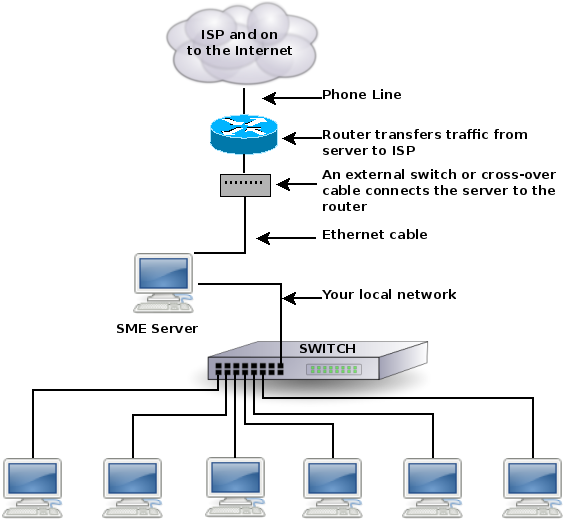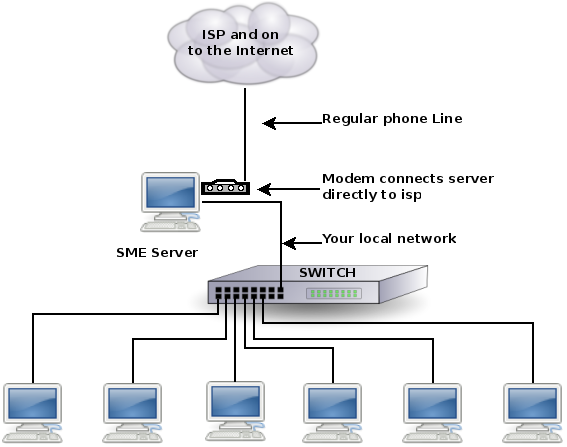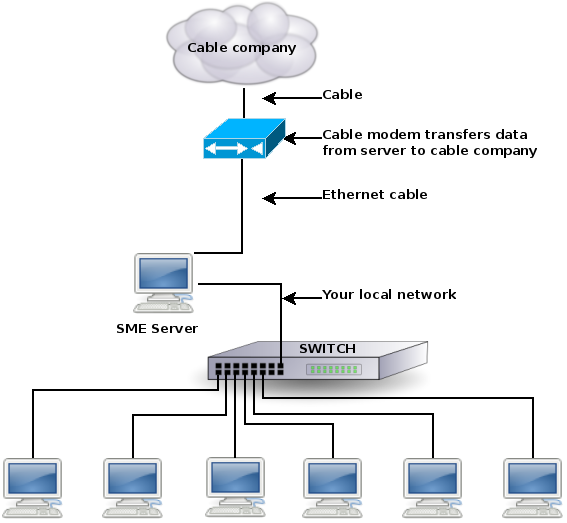Difference between revisions of "SME Server:Documentation:Administration Manual:Chapter3/de"
| Line 4: | Line 4: | ||
Ihr Internet Service Provider oder ISP ist Ihre Verbindung in das Internet - er routet Datenpakete von Ihrem Server in das Internet und umgekehrt und stellt auch weitere grundlegende Dienste bereit. Diese Kapitel des Handbuchs beschreibt die verschiedenen Leistungen der ISP's und wie sich die Wahl unterschiedlicher Optionen auswirken. Wenn auch viele ISP's bei der Einrichtung der Internetdienste für Ihre Organisation behilflich sind, es ist ganz sicher wichtig, grundlegende Kenntnisse über die möglichen Dienste zu haben, denn nicht alle ISP's bieten auch alle Dienste an. | Ihr Internet Service Provider oder ISP ist Ihre Verbindung in das Internet - er routet Datenpakete von Ihrem Server in das Internet und umgekehrt und stellt auch weitere grundlegende Dienste bereit. Diese Kapitel des Handbuchs beschreibt die verschiedenen Leistungen der ISP's und wie sich die Wahl unterschiedlicher Optionen auswirken. Wenn auch viele ISP's bei der Einrichtung der Internetdienste für Ihre Organisation behilflich sind, es ist ganz sicher wichtig, grundlegende Kenntnisse über die möglichen Dienste zu haben, denn nicht alle ISP's bieten auch alle Dienste an. | ||
| − | {{ | + | {{Warnungsbox|Inhalt=Falls Sie Ihren SME Server im Nur Server-Modus betreiben, benötigen Sie die Dokumentation Ihres Geateway/Firewall-Systems und sollten vielleicht die Konfiguration mit Ihrem ISP abstimmen. Beispielsweise müßte Ihr ISP DNS Einträge für Ihren Mail- bzw. Webserver mit Ihrer Firewall-IP-Adresse veröffentlichen. Außerdem müßten Sie dann Ihre Firewall mit Portweiterleitungen für die benötigten Dienste konfigurieren.<br /> |
Der Nur Server-Modus benötigt nur eine einzelne "vertrauliche" Ethernetverbindung innerhalb des lokalen abgesicherten Netzwerks, wobei die Firewallfunktionen ausgeschaltet sind. Deshalb muss ein Server, der im Nur Server-Modus betrieben wird, immer hinter einer lokalen Firewall stehen. Solch ein System darf niemals direkt mit dem Internet verbunden werden.}} | Der Nur Server-Modus benötigt nur eine einzelne "vertrauliche" Ethernetverbindung innerhalb des lokalen abgesicherten Netzwerks, wobei die Firewallfunktionen ausgeschaltet sind. Deshalb muss ein Server, der im Nur Server-Modus betrieben wird, immer hinter einer lokalen Firewall stehen. Solch ein System darf niemals direkt mit dem Internet verbunden werden.}} | ||
Revision as of 16:16, 17 March 2007
Template:Header Template:Dokumentationsübersicht
Ihr Internet Service Provider (ISP)
Ihr Internet Service Provider oder ISP ist Ihre Verbindung in das Internet - er routet Datenpakete von Ihrem Server in das Internet und umgekehrt und stellt auch weitere grundlegende Dienste bereit. Diese Kapitel des Handbuchs beschreibt die verschiedenen Leistungen der ISP's und wie sich die Wahl unterschiedlicher Optionen auswirken. Wenn auch viele ISP's bei der Einrichtung der Internetdienste für Ihre Organisation behilflich sind, es ist ganz sicher wichtig, grundlegende Kenntnisse über die möglichen Dienste zu haben, denn nicht alle ISP's bieten auch alle Dienste an.
Direkte Verbindung versus Einwahlverbindung
Die Verbindung, auch Internet-Zugangsart, bezeichnet die physikalische Anbindung des lokalen Netzwerks zu Ihrem ISP. Die Art der Verbindung zu Ihrem ISP regelt für die Geschwindigkeit des Seitenaufbaus für die lokalen Nutzer, die Erreichbarkeit der veröffentlichten Webseiten für potenziellen Internetbesucher sowie die Zeitdauer des E-Mail-Empfangs.
Direktverbindungen stellen eine Dauerverbindung zu Ihrem ISP dar. Wenn auch häufig teurer, stellen sie grundsätzlich die schnellere Alternative dar und sind deshalb besser geeignet, die ganze Palette der SME Dienste auch zu nutzen. Dabei ist zwischen verschiedenen Arten der Direktverbindung zu unterscheiden. ADSL stellt relativ schnelle Verbindungen über Telefonleitungen bereit. Kabelverbindungen mit einem Kabelnetzbetreiber können das ebenfalls, allerdings kann die verfügbare Geschwindigkeit je nach Nutzung in Ihrer Nachbarschaft auch deutlich langsamer sein.
If you have dialup connectivity, your server is not permanently connected to the Internet. Rather, it connects to your ISP over a phone line using a modem or ISDN adapter . Because your connection to the Internet is not permanent, some of the services on your server cannot be provided to the outside world. For example, having your server host your external company web site would create a problem because whenever your server was not connected to the Internet, the web site would not be available. (However, it could certainly host an intranet web site because the local network would always be connected.)
The IP address
An IP address is an identifying number assigned to all devices connected to the Internet, and is used in routing information from one device to another. Like your phone number, your IP address enables other people to reach you. In our standard configuration, your ISP only needs to allocate one IP address for your network. It is assigned to your server, which will accept all the Internet data packets intended for your network and distribute them to the appropriate computer - much like an office receptionist is able to accept incoming calls and direct them to the appropriate extension.
Static versus dynamic IP addressing
A static IP address never changes. It is permanently assigned to your server by your ISP.
Dynamic IP address assignment means that your IP address is assigned to you only temporarily and may be changed by your ISP. This makes it more difficult to ensure continuity of service to your network. Consider again our telephone number analogy. When your telephone number changes, you are able to place outgoing calls. However, until your new phone number is registered with Directory Services, other people are unable to look up your new number and place calls to you. Similarly, whenever your IP address changes, a record associating your server with its new IP address must be published with the equivalent of Directory Services (known as Domain Name Service or DNS) before incoming traffic can find you.
If your IP address is dynamically assigned and you have a dedicated connection to your ISP (for example, with a typical cablemodem), you may find it helpful to use a dynamic DNS service . We strongly recommend you review Appendix B: Dynamic DNS services for more information about this worthwhile option.
Routable versus non-routable IP addresses
If an IP address is analogous to your phone number, then a routable IP address is the equivalent of a full telephone number complete with country code and area code such as +1-613-555-1234. Using the same analogy, a non-routable address is the equivalent of an office extension. If your server is assigned a non-routable address, it cannot directly receive incoming Internet connections, which limits the services that it can provide to your site.
Arranging connectivity with your ISP
If you are going to be using your server in "server and gateway" mode, you will need to arrange for a connection to the Internet. Your ISP will help you connect your site and provide you with services that enable you to take advantage of the Internet (e.g. e-mail delivery). To some extent, the type of connection used determines the services needed. Therefore, we guide you first through arranging connectivity and then direct you to the appropriate list of services for each type of connection. The terms used in the following sections are defined at the end of this chapter.
To connect your site to the Internet, you not only need to arrange your physical connection (modem, ISDN, DSL, cable modem, etc.), but you also need to ensure that your server can locate the appropriate devices at your ISP's site. Your ISP will give you this information (e.g. IP addresses for their devices) which must eventually be entered into your server console (a straightforward process covered in a later chapter). Many ISPs use a DHCP server which can directly configure your server with some or all of these parameters.
Ordering a corporate ADSL or other commercial dedicated connection
Typically, your ISP will arrange for and configure your external hub and router. Alternatively, you may be required to install that hardware yourself under their direction. If a special phone line is required, the ISP will typically arrange that. It is most typical with corporate service that you receive a routable, static IP address. In fact, usually you will be allocated a block of routable, static IP addresses for your corporation - you will need only one for your server.
 Information provided to you by your ISP:
Information provided to you by your ISP:
- static IP address (or block of addresses from which you choose one)
- IP address of router ("gateway IP address")
- subnet mask
Order services from: Service List A
Ordering cablemodem or residential ADSL service
Typically, your cable company or ADSL provider will install a configured cablemodem or ADSL router at your site. If you do not have cable access, your cable company will install it for you. ADSL connects to the ISP via a conventional phone line. If you require an additional phone line, it is typical for you to arrange that yourself. There are three possible configurations when ordering cablemodem or residential ADSL services.
1. You receive a routable, static IP address Information provided to you by your ISP:
- static IP address
- IP address of cablemodem or ADSL router ("gateway IP address")
- subnet mask
Order services from: Service List A
2. You receive a routable, dynamically assigned IP address and you elect to use a dynamic DNS service (We encourage you to review Appendix B: Dynamic DNS Services for a discussion of dynamic DNS services.) Information provided to you by your ISP:
- gateway IP address*
- subnet mask*
Information provided by dynamic DNS service:
- DNS service account name
- DNS service password
Order services from: Service List B
3. You receive a routable, dynamically assigned IP address and you elect not to use a dynamic DNS service OR your IP address is non-routable. Information provided to you by your ISP:
- IP address of cablemodem or ADSL router ("gateway IP address")*
- subnet mask*
Order services from: Service List D
Ordering a dialup connection
It is typical for you to purchase and install your own modem or ISDN adapter for your dialup connection. (Be sure to use a Linux-compatible modem - ~WinModems will not work.) Your modem connects to your ISP over a conventional phone line. If you require an additional phone line, it is typical for you to arrange that yourself.
 Your ISDN adapter will connect to the ISDN connection installed by your ISP or local telecommunications provider. The software can work with external ISDN adapters and includes support for passive ISDN cards.
Your ISDN adapter will connect to the ISDN connection installed by your ISP or local telecommunications provider. The software can work with external ISDN adapters and includes support for passive ISDN cards.
There are two possible configurations with dialup service: 1. Your ISP is able to meet all of the following three conditions:
- you receive a routable, static IP address
- your ISP will provide a secondary mail server for your domain, which receives e-mail when your server is not connected.
- your ISP is able to accept the "ETRN command". (This command is used by the server to retrieve the mail held by the ISP's secondary mail server.)
Information provided to you by your ISP:
- static IP address
- dialup access number
- dialup account name
- dialup account password
Order services from: Service List C
2. Your ISP is unable to meet all three of the above conditions Information provided to you by your ISP:
- dialup access number
- dialup account name
- dialup account password
Order services from: Service List D
Arranging Services From Your ISP
In each of the previous sections on connectivity, we direct you to the appropriate list of services that should be ordered from your ISP.
Service List A
- domain name set up and hosting
- publication of DNS address records for your web server, FTP server and e-mail server
- publication of DNS mail (MX) records
- secondary mail server (optional)
- Internet news server (optional)
Service List B
Services to order from ISP:
- secondary mail server (optional)
- Internet news server (optional)
Services From Dynamic DNS Service
- domain name (depending on the service purchased, your dynamic DNS service may restrict what your domain name can be)
- publication of DNS address records for your web server, FTP server and e-mail server
- publication of DNS mail (MX) records
Service List C
- PPP dialup access (with static IP)
- domain name
- publication of DNS address records for your e-mail server*
- publication of DNS mail (MX) records
- secondary mail server (ETRN must be supported)
- Internet news server (optional)
Your web and FTP servers are available to the external world only when your server is connected to the Internet. DNS address records for web and FTP servers only need to be published if it is likely that someone external to your site will need to connect to them for a particular reason.
Service List D
Please read the important notes (below) on the limitations of this configuration.
- PPP dialup access (if you are using dialup connectivity)
- POP mailbox (with generous size limitation)
- domain name - route all mail for domain name to the single POP mailbox
- Internet news server (optional)
Service list D is applied to configurations where the publication of DNS records is not practical either because your IP address changes frequently or because it is non-routable. Because there is no published address receiving incoming network connections, this configuration does not allow you to host a web page or FTP site using your SME Server.
In this case, e-mail is handled using a method called "multidrop", which involves temporarily storing all e-mail messages addressed to your domain in a POP mailbox at your ISP until your server connects and fetches them. Your POP mailbox must be large enough to hold the e-mail for your organization until it is fetched. If your primary ISP cannot supply this, you can use another ISP for your e-mail hosting.
As e-mail messages are delivered into the POP mailbox at your ISP, some of the addressee information is removed. To determine to whom the e-mail message is addressed, your server uses several heuristics. This works very well for normal person-to-person e-mail. However, messages from mailing lists (and other sources where the user's account name is not present in the headers) cannot be delivered. Any e-mail that cannot be delivered will be returned to the sender. If the e-mail cannot be returned to sender, it will be directed to the system administrator.
Some ISPs add a header to each e-mail message as it enters the POP mailbox to assist in determining the addressee. One common header tag is: "X-Delivered-To". If your ISP does this, make note of the header tag used so that you can configure your server to look for it (explained in a later section).
Because of the potential problems involved with delivery of e-mail to multidrop mailboxes, we strongly encourage you to consider other means of mail delivery before resorting to using multidrop.
Terms used in ordering connectivity and services
ADSL (or DSL)
ADSL is a type of high-speed Internet access that uses regular phone lines and is available in many metropolitan areas.
Domain Name
This refers to the unique name attached to your organization on the Internet. For example, "tofu-dog.com" or "e-smith.com". If you don't have a domain name, your ISP can help you select one, ensure it is available, and register it.
DNS (Domain Name Service)
DNS, or Domain Name Service, refers to the software and protocols involved in translating domain names to IP addresses. Your server provides DNS lookup services for your local network, and your ISP typically also provides you with the IP addresses of DNS servers. These servers do not need to be configured into your server as the DNS server that is provided with your server will correctly resolve all local and Internet names.
DNS: Publication of DNS Address Records
The publication of DNS address information allows other DNS servers to look up
your domain information. Your ISP must publish DNS address records associating the
name of your web server ("www.domain.xxx"), FTP server ("ftp.domain.xxx") and e-mail
server ("mail.domain.xxx") with the IP address of your server.
DNS: Publication of DNS Mail (MX) Records
The publication of DNS mail (MX) records is the method used to inform Domain Name Services
worldwide that all e-mail to your domain ("yourdomain.xxx") should be delivered to
your e-mail server ("mail.yourdomain.xxx").
ETRN
ETRN is a command used for dialup solutions in order to retrieve e-mail temporarily stored at your ISP
Gateway IP Address
A gateway is the device on your network that forwards packets to and from the Internet.
